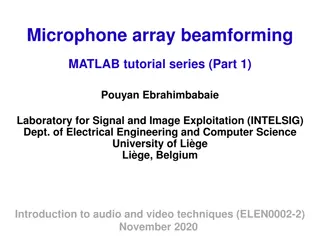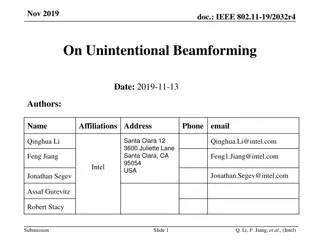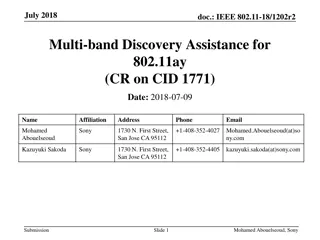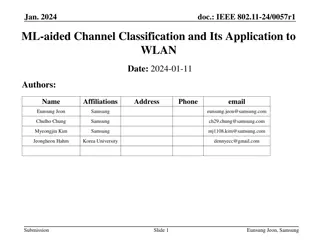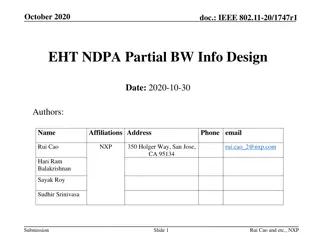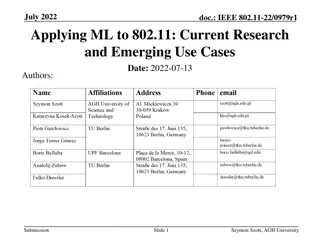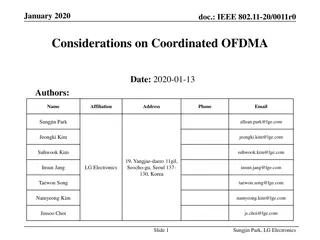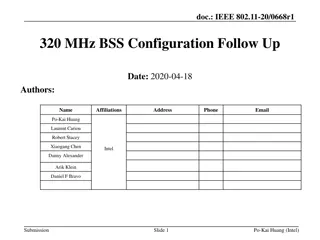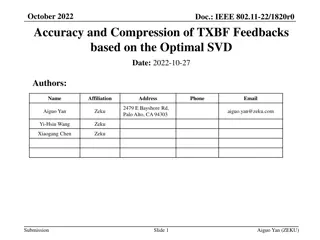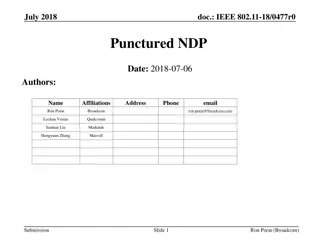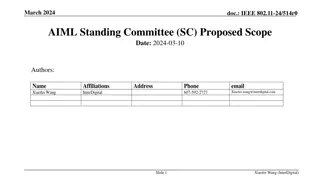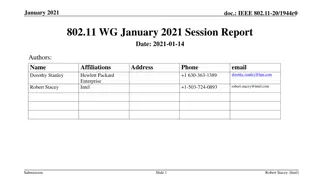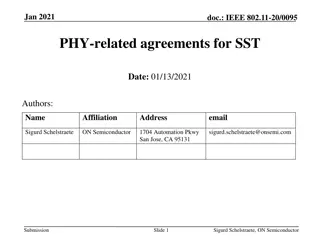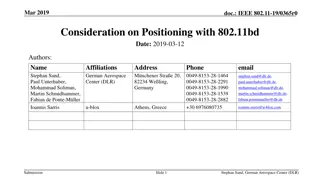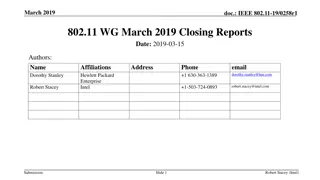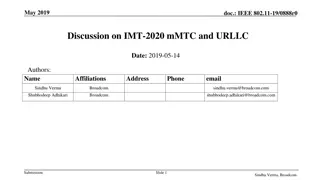IEEE 802.11-19/1517r0 TDD Beamforming Configuration Overview
IEEE 802.11-19/1517r0 discusses TDD beamforming operations related to Beam Measurement in the standard. Before Draft 4.0, these operations were primarily initiated by SME, causing limitations due to proprietary network controllers. The document reviews gaps and improvements in TDD beamforming, aiming to standardize operations and avoid proprietary software dependencies. It outlines the background of TDD beamforming, challenges with proprietary network controllers, and proposed enhancements for standardized management functions and operations.
Download Presentation

Please find below an Image/Link to download the presentation.
The content on the website is provided AS IS for your information and personal use only. It may not be sold, licensed, or shared on other websites without obtaining consent from the author. Download presentation by click this link. If you encounter any issues during the download, it is possible that the publisher has removed the file from their server.
E N D
Presentation Transcript
IEEE 802.11-19/1517r0 September 2019 TDD beamforming configuration Date: 2019-09-18 Name Affiliation Address Phone Email Payam Torab Facebook torab@ieee.org Djordje Tujkovic djordjet@fb.com Krishna Gomadam kgomadam@fb.com Lakshmi Pradeep lpradeep@fb.com Submission Slide 1 Payam Torab, Facebook
IEEE 802.11-19/1517r0 September 2019 TDD beamforming Background TDD beamforming operations other than Initial Beamforming* are referred to as Beam Measurement in the standard Before Draft 4.0, these operations were exclusively initiated by (and results reported to) SME o Requiring connection to (proprietary) network controller o For client devices (non-AP STAs) connection to (proprietary) controller is undesirable Proprietary connection (software) impedes commercialization We review some TDD beam measurements operations for some gaps Submission 2 Payam Torab, Facebook
IEEE 802.11-19/1517r0 TDD beamforming Background Proprietary Network Controller Before Draft 4.0 Proprietary management port Proprietary management port Standard 802.11ay MAC plus some proprietary functions DNs and CNs requiring proprietary software Proprietary Management Proprietary Management Proprietary 802.11ad|ay MAC 802.11ad|ay MAC Standard 802.11ad PHY DN (AP) 802.11ad PHY CN (non-AP) Standard Improvement Proprietary Network Controller TDD Sector Config Proprietary management port Standard 802.11ay MAC including standard management functions DNs requiring proprietary software CNs 60 GHz operation entirely specified by 802.11 (no need for proprietary software) CN with standardized data plane and management plane 802.11 Management 802.11 Management Standard 802.11ad|ay MAC 802.11ad|ay MAC Standard 802.11ad PHY DN (AP) 802.11ad PHY CN (non-AP) Standard August 2019 Submission 3 Payam Torab, Facebook
IEEE 802.11-19/1517r0 September 2019 Example -- Periodic beamforming (PBF) Initiator MLME (and TDD Sector Config fields) Example implementation Generalized Initiator transmitting on different Tx beams during beamforming slot every 400 s, cycling through all Tx beams (Note 1) Initiator trying Ntx transmit beams against Nrx responder s receive beams, during periodic or irregular (but scheduled) beamforming slots (Nrx = 1 for current implementation) Start time Period P or schedule (already provided) TDD SSW multiplicity (Note 3) Transmission pattern repeated 31 times, with responder measuring on a different receive beam during each transmit cycle Initiator trying a generally different Tx Beam at every new Beamforming slot (taking Ntx slots for Tx sweep) (Note 2) Set of Rx beams (Note 4) Responder reporting the result through the controller Responder receiving on each Rx beam Ntx times, so it can try them against all different Tx beams Non-AP (CN) can also be the initiator Can be locally decided by non-AP, or administered through the AP/controller Start time pointing to start of the first beamforming slot used for operation; schedule assumed consistent with beamforming pattern and duration Decided by non-AP: Send up the request (same arguments minus the schedule), get acknowledgement, schedule, start time (exchange of TDD Sector Config subelement) Notes (1) (2) (3) (4) Equivalent to an 802.11ad I-TXSS (directional receive) Some or all of Tx beams can be the same, e.g., for averaging Knowing the TDD SSW multiplicity can help with averaging decisions Set of Rx beams can be null to leave the Rx selection to responder Allow TDD SSW Feedback and TDD SSW Ack, with option to skip Decided by AP: Same as runtime Rx calibration, except Tx beam selection is left to non-AP (see the runtime Rx calibration slide) Responder sends SNR report to initiator through TDD Route IE (TDD Sector Feedback subelement) Initiator does not send a SNR report Submission 4 Payam Torab, Facebook
IEEE 802.11-19/1517r0 September 2019 Example Transmit beam calibration Initiator MLME (and TDD Sector Config fields) Example implementation Generalized Initiator transmitting on generally different Tx beams during beamforming slot every 400 s (Note 1, 2) Initiator trying Ntx transmit beams against Nrx responder s receive beams, during periodic or irregular (but scheduled) beamforming slots (Nrx = 1 for current implementation) Start time Period P or schedule (already provided) TDD SSW multiplicity (Note 3) Responder measuring signal in corresponding beamforming slots using the current Rx beam Initiator trying a generally different Tx Beam at every new Beamforming slot (taking Ntx slots for Tx sweep) (Note 2) Set of Rx beams (Note 4) Responder reporting the result through the controller Responder receiving on each Rx beam Ntx times, so it can try them against all different Tx beams Non-AP (CN) can also be the initiator Can be locally decided by non-AP, or administered through the AP/controller Start time pointing to start of the first beamforming slot used for operation; schedule assumed consistent with beamforming pattern and duration Decided by non-AP: Send up the request (same arguments minus the schedule), get acknowledgement, schedule, start time (exchange of TDD Sector Config subelement) Allow TDD SSW Feedback and TDD SSW Ack, with option to skip Notes (1) (2) (3) (4) Decided by AP: Same as runtime Rx calibration, except Tx beam selection is left to non-AP (see the runtime Rx calibration slide) Equivalent to an 802.11ad I-TXSS (directional receive) Some or all of Tx beams can be the same, e.g., for averaging Knowing the TDD SSW multiplicity can help with averaging decisions Set of Rx beams can be null to leave the Rx selection to responder Responder sends SNR report to initiator through TDD Route IE (TDD Sector Feedback subelement) Initiator does not send a SNR report Submission 5 Payam Torab, Facebook
IEEE 802.11-19/1517r0 September 2019 Example Rx Beam calibration Initiator MLME (and TDD Sector Config fields) Example implementation Generalized Initiator trying generally different Rx beams during each beamforming slot every 400 s (Note 1, 2) Initiator trying Nrx receive beams against Ntx responder s transmit beams, during periodic or irregular (but scheduled) beamforming slots (Ntx = 1 for current implementation) Start time Period P or schedule (already provided) TDD SSW multiplicity (Note 3) Responder transmitting TDD SSW frames in corresponding beamforming slots on the current Tx beam Initiator trying a generally different Rx Beam at every new Beamforming slot (taking Nrx slots for Rx sweep) (Note 2) Set of Tx beams (Note 4) Initiator reporting the result through the controller Responder transmitting on each Tx beam Nrx times, so initiator can try them against all different Rx beams Non-AP (CN) can also be the initiator Can be locally decided by non-AP, or administered through the AP/controller Start time pointing to start of the first beamforming slot used for operation; schedule assumed consistent with beamforming pattern and duration Decided by non-AP: Send up the request (same arguments minus the schedule), get acknowledgement, schedule, start time (exchange of TDD Sector Config subelement) Allow TDD SSW Feedback and TDD SSW Ack, with option to skip Decided by AP: Same as runtime Tx calibration, except Rx beam selection is left to non-AP (see the runtime Tx calibration slide) Notes (1) (2) (3) No SNR report exchanged Equivalent to an 802.11ad I-RXSS Some or all of Rx beams can be the same, e.g., for averaging Initiator specifying the TDD SSW multiplicity to control averaging decisions Set of Rx beams can be null to leave the Rx selection to responder (4) Submission 6 Payam Torab, Facebook
IEEE 802.11-19/1517r0 September 2019 Example Interference measurement Initiator or AP MLME (and TDD Sector Config fields) Example implementation Generalized Initiator transmitting on generally different Tx beams during beamforming slot every 400 s (Note 1, 2) Broadcast RA for TDD SSW frames Number of beamforming slots in the schedule given to initiator does not have to be a multiple of number of scanned Tx beams For example, 100 slots may be allocated for interference scan using 31 Tx beams Start time Period P or schedule (already provided) TDD SSW multiplicity (Note 3) o o Multiple responders measuring signal in corresponding beamforming slots using their current Rx beams With invert scan polarity measurement slots are sometimes scheduled in the Tx subframe (i.e., where the device is normally expected to transmit) (supported by Slot Schedule IE general format, no standard change needed) Set of responders Different responders schedules (and obviously Rx beams)(this is more generalizing the procedure than generalizing any protocol) For example, one responder scanning during a portion of the 100 slots in the above example, while another responder scanning during the entire 100 slots Set of Rx beams (Note 4) TA address (Note 5) o o Non-AP (CN) can also be the initiator Can be locally decided by non-AP, or administered through the AP/controller Responders reporting the result through the controller Decided by non-AP: Send up the request (same arguments minus the schedule, plus list of responders (e.g., some of RAs that have been received), get acknowledgement, schedule, start time (exchange of TDD Sector Config subelement) Any device can be the initiator (DN or CN) No notion of BSS association for different responders (network-level operation) Decided by AP or another STA outside BSS (request coming to AP through the controller): MLME/AP config parameters above Notes (1) (2) (3) Sweep can be repeated (is ended administratively) Some or all of Tx beams can be the same, e.g., for averaging Responder knowing the TDD SSW multiplicity can help with averaging decisions Set of Rx beams can be null to leave the Rx selection to responder TDD Sector Config exchange for another TA not in BSS (4) (5) Submission 7 Payam Torab, Facebook
IEEE 802.11-19/1517r0 September 2019 Coordinated beamforming Transmit training Initiator or AP MLME (and TDD Sector Config fields) Generalized Example implementation Network level interference nulling operation involving an aggressor link and multiple victim links: Finding the Tx beam with least interference to multiple victims Number of beamforming slots in the schedule given to initiator does not have to be a multiple of number of scanned beams For example, 100 slots may be allocated to scan 31 Tx beams Start time Period P or schedule (already provided) TDD SSW multiplicity (Note 3) Initiator (on aggressor link) transmitting on generally different Tx beams during beamforming slot every 400 s (Note 1, 2) Set of responders Different receive schedules (and Rx beams) for each victim link (this is more generalizing the procedure than generalizing the protocol) For example, one responder receiving during a portion of the 100 slots in the above example, while another responder receiving during the entire 100 slots Set of Rx beams (Note 4) Multiple responders (on multiple victim links) receiving on a given Rx beam during beamforming slots allocated to them (with invert scan polarity sometimes this may happen in the opposite subframe) TA address (Note 5) Non-AP (CN) can also be the initiator Probably can be administered through the AP/controller only (under study) Responders reporting the result through the controller Any device can be the initiator (DN or CN) Notes (1) Sweep can be repeated (is ended administratively) (2) Some or all of Rx beams can be the same, e.g., for averaging (3) Knowing the TDD SSW multiplicity can help with averaging decisions (4) Set of Rx beams can be null to leave the Rx selection to responder (5) TDD Sector Config exchange for another TA not in BSS (6) Operation is runtime Tx calibration on aggressor (responders receiving on constant receive beams) + TA filtering No notion of BSS association for different responders (network-level operation) Aggressor link ATX (initiator) ARX VTX1 VRX1 VTX2 VRX2 Submission 8 Payam Torab, Facebook
IEEE 802.11-19/1517r0 September 2019 Coordinated beamforming Rx training (Rx CBF) Initiator or AP MLME (and TDD Sector Config fields) Generalized Example implementation Network level interference nulling operation involving multiple aggressor links and a victim link: Finding the Rx beam with least interference from multiple aggressors Number of beamforming slots in the schedule given to initiator does not have to be a multiple of number of scanned beams For example, 100 slots may be allocated to scan 31 Rx beams Start time Period P or schedule (already provided) TDD SSW multiplicity (Note 3) Initiator (on victim link) receiving on generally different Rx beams during beamforming slot every 400 s (Note 1, 2) Set of responders Different transmit schedules (and Tx beams) for each aggressor link (this is more generalizing the procedure than generalizing the protocol) (Note 7) For example, one responder transmitting during a portion of the 100 slots in the above example, while another responder transmitting during the entire 100 slots Set of Rx beams (Note 4) Multiple responders (on multiple aggressor links) transmitting on a given Tx beam during beamforming slots allocated to them (with invert scan polarity sometimes this may happen in the opposite subframe) TA addresses (Note 5) Non-AP (CN) can also be the initiator Probably can be administered through the AP/controller only (under study) Initiator reporting the result through the controller Any device can be the initiator (DN or CN) Notes (1) Sweep can be repeated (is ended administratively) (2) Some or all of Rx beams can be the same, e.g., for averaging (3) Knowing the TDD SSW multiplicity can help with averaging decisions (4) Set of Rx beams can be null to leave the Rx selection to responder (5) TDD Sector Config exchange for other TAs not in BSS (6) Operation is runtime Rx calibration on victim (responders transmitting on constant transmit beams) + TA filtering (7) Interference measurement with simultaneous transmission is problematic 802.11ad/ay directional channel measurement (ANIP and RSNI) with TDD extensions may be applicable No notion of BSS association for different responders (network-level operation) Victim link VTX VRX (initiator) ATX1 ARX1 ATX2 VRX2 Submission 9 Payam Torab, Facebook
IEEE 802.11-19/1517r0 September 2019 Next step Enhancing the TDD Sector Config subelement Add more information about o Sweeping pattern/schedule o Information from outside the BSS For example, list of aggressor TA addresses during Rx CBF Submission 10 Payam Torab, Facebook



